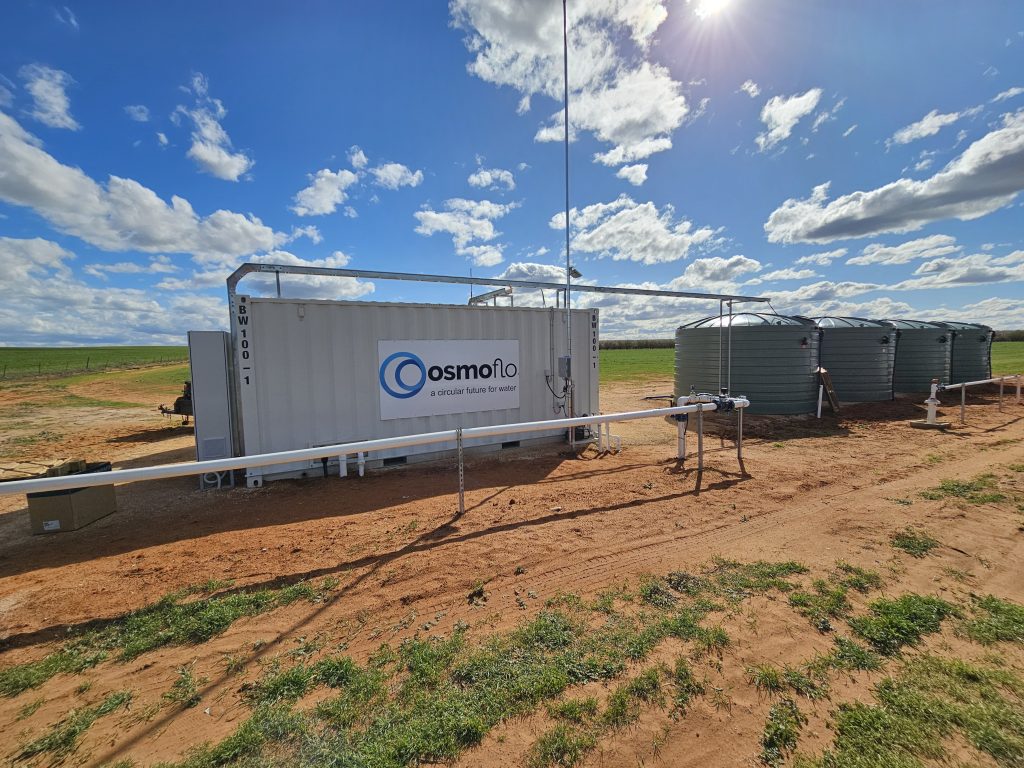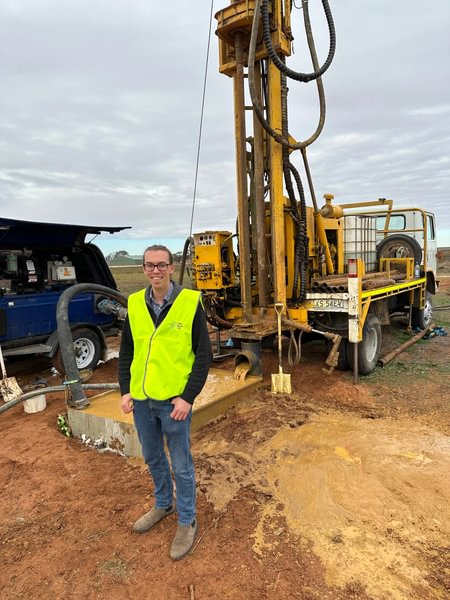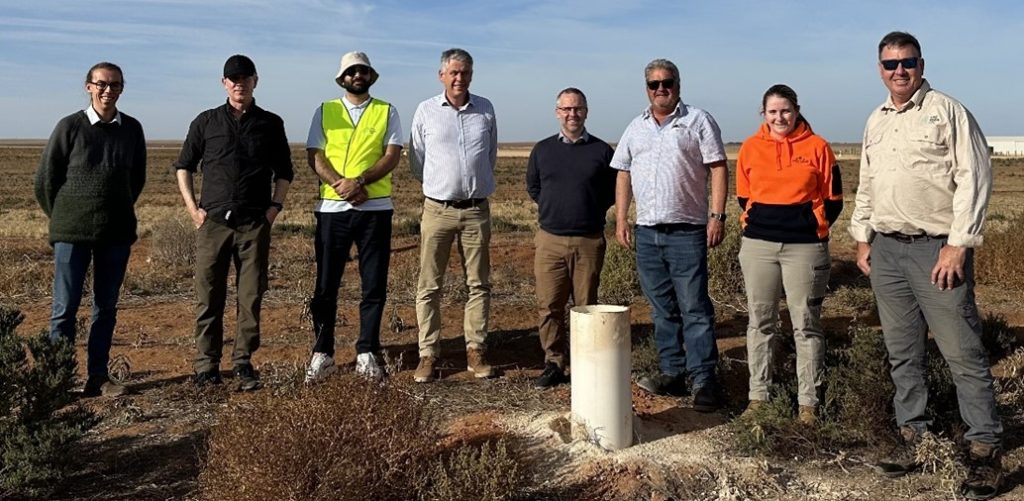Quickstart project draws an affordable solution for high-value horticulture from deep underground
news
Published 16 Sep 2024
When a small desalination plant was switched on at an almond orchard near Loxton last month, it signalled a new chapter in groundwater treatment that could hold significant promise for premium growers across the basin.
Since the Millennium Drought, reverse-osmosis desalination has proved a silver bullet for Australia’s precarious urban water supplies, with desalination plants topping up reserves in every coastal capital apart from Hobart and Darwin. But when it comes to the aquifers of the Murray-Darling Basin, reverse osmosis – which pushes saline water through polymeric membranes at extremely high pressure – has long been considered too energy-hungry for cost-conscious farmers.
That may be about to change. Last month, the launch of a small reverse-osmosis (RO) plant on an almond grove in South Australia’s Riverland provided both its hosts and hydrologists with hope of a new source of fresh water that could help to alleviate pressure on the hard-pressed Murray River.
The unique potential of the project at Century Orchards is that, unlike most inland RO plants, which treat leftover brine in a series of evaporation ponds that keep salt on the surface, this project injects it into an already saline aquifer that stores it safely underground.
Century Orchards’ CEO Brendan Sidhu believes the trial will provide a ‘gamechanger’ for his farm, which would not have been possible without One Basin’s multidisciplinary connections – linking some of the country’s leading groundwater hydrologists with regulators and the Adelaide-based desalination pioneer, Osmoflo.
‘Bringing all these leaders together has produced something with significant implications for the greater good,’ says Sidhu. ‘All our partners in this project are committed to the same goal, which is protecting the precious fresh water that we have to share.’
Word has quickly spread about the Loxton trial, which although not the first RO plant in the basin, is the first to draw groundwater from a deep aquifer and dispose of the brine in a separate, geologically-distinct aquifer – which passes the test of being more saline than the brine itself.
In the first month, more than 30 farmers and water managers have visited the site, confirming growing interest in the potential for small-scale desalination to water almonds, vines, and other high-value crops struggling with reduced allocations of river water.

Quick wins
Led by the seasoned University of Adelaide hydrologist, Dr Michael Leonard, the groundwater project is one of 10 ‘quickstart’ projects launched by One Basin CRC in 2023 to tackle some of the most pressing challenges facing water managers and farmers in the Murray-Darling Basin.
The potential for ‘quick wins’ proved particularly propitious at Century Orchards, where the farm had already drilled two bores to facilitate its own groundwater research. These bores enabled Leonard’s team to fast track its installation of an Osmoflo system – neatly packed into a 20-foot shipping container – and a pilot project watering nine rows of almonds: three with desalinated water, three with half desalinated-half river water, and three with river water.
When the almonds are harvested from next March, the farm will be keeping a close eye on the quality of the crop – and on its sums.
‘If we can get the cost down to less than $500 a megalitre, it should work for us,’ Sidhu believes. ‘At the moment, if we have a dry year with a 50% allocation of our riverwater lease, we can be spending up to $700 a megalitre – so our target with this trial is to get the cost down to $400-500 per megalitre.
‘We obviously have to see how the trees react, but with early testing of this water I can’t see this being a problem. The biggest factor will be the power costs, so in the future we will probably be looking to invest in a solar farm to bring these costs down further.’

Proof underground
For Leonard and his colleagues, the ‘proof’ of the project is equally focused on management of the brine: ensuring there are no adverse environmental consequences for the receiving aquifer, the bores do not clog, and the process proves more affordable than evaporation ponds.
Leonard says the brine discharge is effectively diluting the receiving aquifer. ‘The source water has a salinity of 12,500 parts per million, the receiving aquifer has salinity akin to seawater at 35,000 parts per million, and the brine resulting from the ‘low recovery’ setting of our RO plant is only 17,500 parts per million,’ he explains.
‘The environmental consequences are minimised because there’s an impermeable clay layer between the source and receiving aquifers, and the RO plant needs no additional chemicals as part of its treatment.’
Leonard believes the project has the potential to treat groundwater at multiple sites across the basin where there are aquifers separated by rock or clay. ‘We believe there are around 2,000 gigalitres of groundwater that could be sustainably extracted in the basin each year, based on estimates by CSIRO of sustainable yields of brackish and saline groundwater in the four basin states,’ he says.
‘For horticulture, where there’s a permanent plantation and a premium product such as almonds or vines, the value proposition appears quite compelling.’
Over the coming months, Leonard and co-researcher Peter Reeve will take up to 30 farmers on monthly tours of the site, with the potential to take over 200 visitors in total. The pair believe that growing water uncertainty in the basin will push more farmers to consider solutions beneath their feet.
‘The problem with droughts is that you don’t know you’re in one until you’re in the middle of one, and if you start your planning at that point, it’s too late,’ says Leonard. ‘We know that bigger droughts are coming – and we want people to have better options when the next drought comes.’
Hub connections
Michael Leonard credits Kym Walton, manager of One Basin’s Loxton hub, with ‘incredible’foundation-building for the project. ‘Kym has a lot of respect in the local farming community, and he unlocked a lot of conversations and goodwill for us,’ he says.
‘He arranged tours to 14 potential sites before we landed on Century Orchards as a partner. He also connected us with numerous collaborators – including Andrew Ross at ANU, Terry Fagg at Western Downs Council, Joel Vanderpeer at the SA Department of Environment and Water, and Olga Barron at CSIRO.’

Dr Okke Batelaan, professor of hydrogeology at Flinders University and One Basin’s education and training lead, has long experience with groundwater across the Murray-Darling Basin and believes this project is “one of the most original to come out of a CRC”.
‘There’s lots of brackish groundwater across the basin that’s not being used,’ Batelaan says. ‘With reverse osmosis and growing opportunities for cheap solar energy, I believe this project presents a major new opportunity – and one that can only be realised through a mechanism like One Basin CRC.’
As well as the bores, generator, pumps, and countless man hours provided by Century Orchards, the project has received support from Riverland Irrigation and LecLogix, which provided hydraulic and electrical services respectively, and Osmoflo’s 12-month donation of a 100 kilolitre-per-day RO plant.
‘Osmoflo sees a lot of potential in this project, which is why we’ve been happy to commit both cash and equipment to it,’ says Osmoflo’s CTO, Neil Palmer. ‘Right now, we’re using a diesel generator but if we could switch to solar power, I think the combination of sustainability and responsibility would give Century Orchards a real edge in the premium markets of Asia.
‘We’re very confident that this is a compelling model for other farmers to come and take a look at.’
Calculating the costs
As well as proving up its water production and environmentally-benign brine disposal, the One Basin project has a third arm which will increase its appeal to farmers: the development of a ‘cost calculator’ similar to one homeowners use to estimate savings from rooftop solar.
The calculator, which should be available in a beta version later this month, will enable farmers to calculate the costs and returns of an RO plant based on their aquifer water quality, the demands of their crops, available energy, and emerging climate scenarios.
‘There are multiple possibilities for follow-up projects using different crop types and energy options,” says Leonard. “This trial has focussed on brackish water under a drought resilience scenario, but another option would be to look at the economics of greenhouses – in other words, combining ‘expensive’ treated water with new and different crop types that return a premium value.’
For more information:
- visit the brackish groundwater project project page
- watch webinar on this project on YouTube
- register to tour the demonstration site in Loxton.
Latest news & events
All news & eventsWebinar recording: Working With Country To Heal
Read MoreBuilding capacity for Basin communities to respond to variable water futures
Read MoreDelivering the Commonwealth Environmental Water Holder’s (CEWH) Flow-MER 2025 Annual Forum
Read MoreMurray Darling Association 2025 National Conference: Griffith drives Basin-wide water collaboration
Read More